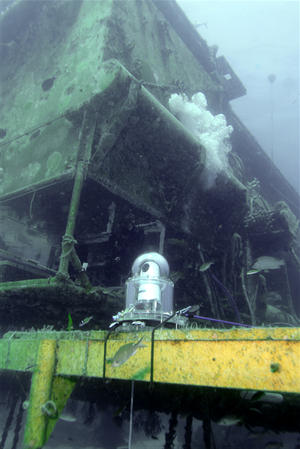Underwater surveillance technologyMarine camera, integrated software offer improved underwater surveillance, security
Underwater surveillance is one of the more difficult tasks for security personnel; darkness, humidity, murkiness, low temperature all make it difficult for camera equipment to capture clear images of elements in water; a new marine camera with integrated software offers a solution

Aquarius deployed // Source: Ocean Presence Technologies
The first strike of Japan’s sneak attack on American fleet at Pearl Harbor on 7 December 1941 came not from above, as commonly assumed, but from below. Nearly two hours before the first wave of Japanese torpedo bombers and dive bombers made their first run at the U.S. battle fleet that Sunday morning, five Japanese midget submarines attempted to infiltrate Pearl Harbor under water. The American destroyer USS Ward detected the advancing pack of underwater warships as they advanced toward the harbor entrance, fired on the lurking submarines, and successfully sank all five.
The USS Ward relied on surface streaks left by the midget submarines, the Ward sailors’ own able seamanship, and sheer luck in depth charging and sinking the intruders. Even then, though, the Americans could not identify the intruders as Japanese, until after that day’s fateful air attack.
The innovative Lyyn Visual Enhancement Technology and integrated underwater cameras allow harbor and marine security to monitor underwater activity at harbor entrances, near oil rigs, and secure marine locations. It may be argued that had the U.S. Navy possessed such technology at Pearl Harbor, it would have been relatively easy to identify the infiltrating Japanese submarines sooner and sound a general alarm in time to scramble US defenses.
The Swedish company says its technology uses special imaging techniques to enhance the pictures transmitted by underwater surveillance cameras, enabling the person monitoring the screen to see important details in crystal-clear color. With this system, security personnel can view underwater structures for normal changes in conditions, or be on the lookout for sabotage or terrorist interference.
The integrated software, distributed by Roper Resources Ltd. and Symphotic Tii Corporation, removes the interference and dark green hue of the sea water, enhancing the remaining colors to provide a true rendering of the subject. The software is being used in a number of applications, including security and surveillance operations in both public and private facilities.
The company says that with the use of this technology, underwater video surveillance and security systems can detect — in real-time — dangerous and threatening situations. Chris Roper CEO of Roper Resources, explains that “most long range surveillance cameras usually provide a fuzzy outline of a subject due to environmental interferences, however, the Lyyn technology eliminates distortions caused by fog, snow, or sand in desert combat situations, making it an idea surveillance device.”
Robert Aston, the president and founder of Santa Cruz, California-based Ocean
